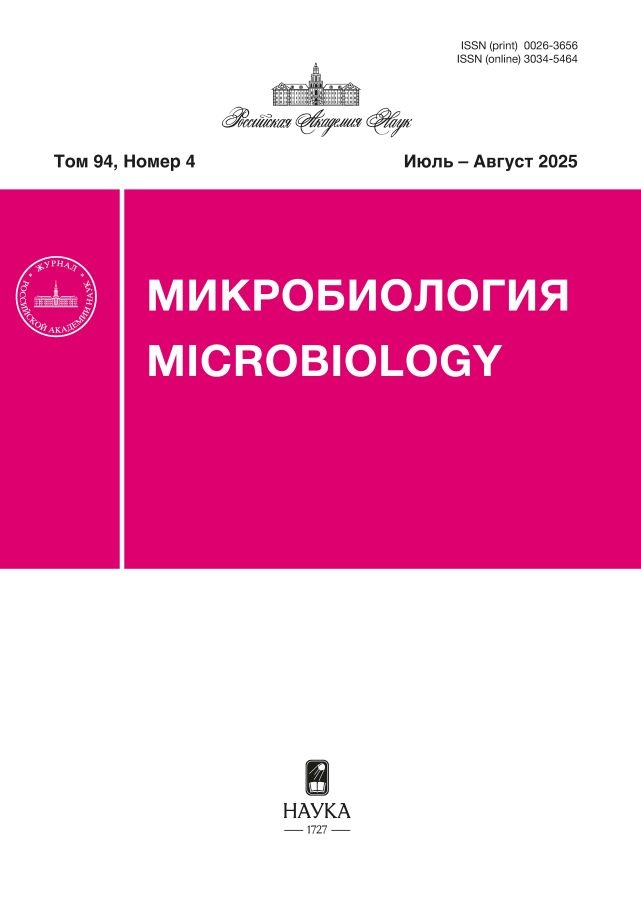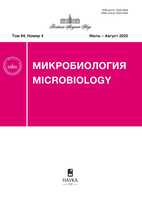Microbiology
ISSN (print):0026-3656
Media registration certificate: No. 0110237 dated 02/09/1993
Founder: Russian Academy of Sciences, Institute of Microbiology RAS
Editor-in-Chief: Pimenov Nikolay Viktorovich
Number of issues per year: 6
Indexation: RISC, list of Higher Attestation Commissions, CrossRef, White List (level 2)
Current Issue
Vol 94, No 4 (2025)
REVIEWS
Biofilms as a presumed basic form of microorganisms existence: modern concepts
Abstract
The review analyzes current information on the processes of formation of microbial biofilms, both fixed on biotic and abiotic surfaces, and arising as a result of autoaggregation and coaggregation in the thickness of the liquid. The physicochemical phenomena occurring during recognition of the phase boundary surface by microorganism cells are described in detail. The components of the extracellular polymer matrix of biofilms, the regulation of their formation, the structural significance for the architecture of biofilms and the protective role when exposed to biocides (including antibiotics) and other adverse environmental factors are described in detail. Approaches to managing the formation of microbial biofilms are considered. A new scheme for the formation of microbial biofilms proposed in the literature, including three stages instead of five, is analyzed.
 303-329
303-329


EXPERIMENTAL ARTICLES
Effectiveness of microalgae and cyanobacteria cryopreservation (for the strains from the All-Russian Collection of Microorganisms)
Abstract
The efficiency of cryopreservation of cyanobacteria and eukaryotic microalgae of different taxonomic groups, including charophyte, chlorophyte and ochrophyte microalgae, was assessed using 24 strains of the algological part of the All-Russian Collection of Microorganisms (VKM) as an example. Microalgae cultures differing in cell size, morphological organization of the thallus, reproduction method, presence and size of mucous membranes, and ability to form dormant cells were selected for comparative study. Two types of cryoprotectors (methanol and dimethyl sulfoxide), two types of nutrient media (slant agar and liquid medium), and three methods for determining the survival of microalgae after cryopreservation were tested. It was shown that a two-step cryopreservation protocol using both cryoprotectants (methanol and dimethyl sulfoxide) was successfully applied to all 24 studied strains, regardless of their taxonomic affiliation and morphological features. Based on the results of the experiment, a standard operating procedure for cryopreservation of microalgae was developed, including a liquid culture medium with dimethyl sulfoxide, as well as two methods for determining the survival of microalgae after cryopreservation – growth in a liquid medium and streaks on agar. The proposed protocol not only ensures the preservation of cell viability and the possibility of further use of the strain as a morphologically and genetically representative sample, but also minimizes time and resource costs, as well as the risk of contamination of cultures.
 330-340
330-340


Effect of biogenic polyamines on rifampicin accumulation in Escherichia coli cells
Abstract
The biogenic polyamines are well known to regulate cell wall permeability for antibiotics permeating the cell via porins. The effect of polyamines on the antibiotics transported by the non-porin route, such as rifampicin, has not been studied. In this work, the effect of intracellular putrescine, spermidine, and cadaverine on the efficiency of rifampicin accumulation, the bacterial susceptibility to rifampicin, the hydrophobicity of the cell surface, as well as the effect of polyamines on the expression of the marRAB operon was tested. None of the three polyamines studied affected the rate of rifampicin transport into the cell at the early stages (2 min). Under the longer exposure (60 min) a protective effect of cadaverine was observed, since the accumulation of rifampicin in cadaverine-free cells was higher compared to cadaverine-proficient ones. The absence of cadaverine in Escherichia coli cells increased their hydrophobicity. There was a direct relationship between the degree of hydrophobicity of the cell surface and the efficiency of rifampicin accumulation. Polyamines themselves did not affect the expression of marRAB operon, but modulated its expression induced by salicylate. Putrescine had no effect, spermidine decreased and cadaverine increased the expression level. Overall, polyamine biosynthesis plays a role in bacterial adaptation to rifampicin, as the strains unable to synthesize cadaverine or putrescine and spermidine were more sensitive than the wild-type strains. Cadaverine plays a special role in protecting against the effects of rifampicin; its intracellular concentration affected bacterial susceptibility to rifampicin.
 341-350
341-350


SHORT COMMUNICATIONS
Genome mapping of RNA‒DNA hybrids in Escherichia coli
Abstract
We have mapped RNA‒DNA hybrids in the prokaryotic genome for the first time. Using the S9.6 antibody immunoprecipitation method (S9.6-DRIP) followed by whole-genome sequencing, we identified 219 unique peaks of RNA‒DNA hybrids in the genome of Escherichia coli TOP10. These peaks corresponded to 219 different genes and were predominantly distributed in the coding regions of the genome (88.12%). Analysis of individual genes containing RNA‒DNA hybrids revealed that they encode enzymes involved in important energy and metabolic processes in prokaryotes, such as lipoic acid synthesis.
 351-355
351-355


Development of a protocol for transformation of Lacticaseibacillus paracasei RG
Abstract
Lactic acid bacteria, traditionally used in the food industry, are considered as a platform for the creation of recombinant strains for the expression and delivery of protectively significant antigens and other biologically active molecules to the gastrointestinal tract of farm animals and humans. One of the obstacles to obtaining recombinant strains of lactic acid bacteria is their low efficiency of plasmid DNA transformation. The probiotic strain Lacticaseibacillus paracasei RG, safe and able to overcome the acidic barrier of the stomach, was chosen as the object of research. The effect of growth conditions, preparation of competent cells and the electroporation mode on the efficiency of L. paracasei RG transformation with the pTRKH2 vector was studied, as a result of which a protocol for efficient transformation of L. paracasei RG with recombinant DNA was created.
 356-360
356-360












